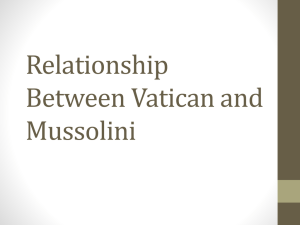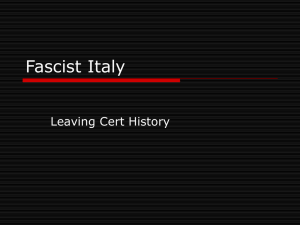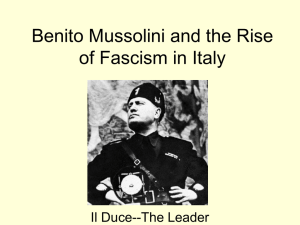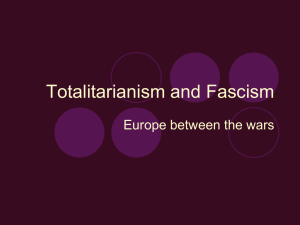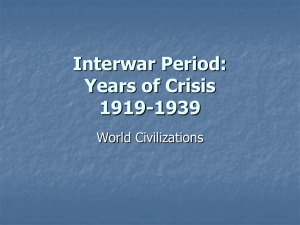File
advertisement
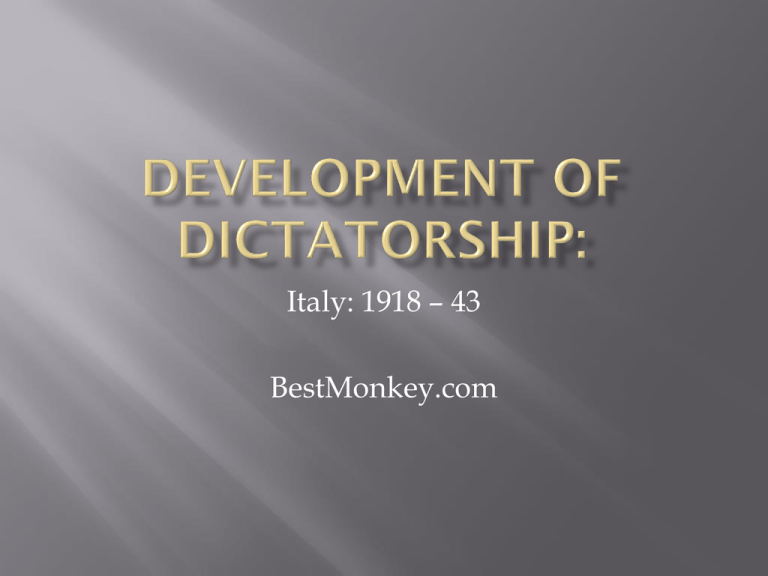
Italy: 1918 – 43 BestMonkey.com Proportional representation: coalitions Politicians all liberal-minded: no party No policies Politicians acted independently - no accountability Trasformissimo – unstable government Catholics boycotted all elections 1915 Treaty of London: Tyrol, Dalmatia, Istria June 1919: Italy ignored in negotiations Sept 1919 Treaty of St. Germain – south Tyrol and Trentino but not Fiume (Yugoslav) Nationalists: disgrace ‘mutilated victory’ Occupation Fiume: September 1919 D’Annunzio led 2000 armed men Public humiliated and angry Heavy losses: 650,000 killed, 1m wounded Unemployment: 2m by 1919 Wage cuts: 25% down (1915-18) Inflation (prices): up 400% Middle class savings wiped out Armaments industries profiteered from war, Fiat and Pirelli tyres profit most Socialist Party membership grew: 1914 – 50,000 1919 – 200,000 Revolutionary strategy (previous reformists) Dictatorship of the proletariat Socialist Republic (Bolshevik revolution Russia) Distribute land and wealth evenly Nov’ 1919 elections = 156 seats (biggest party) Treaties of Versailles & St Germain Fiume: weak and ineffective response National debt from 16bn(1914-1919) 85bn lira Printed money and spending cut back Industry suffered and went into depression Socialist threat: remained neutral towards socialist strikes and farm labourers occupation Giolitti urged industrialists to make concessions to strikers Land owners to give farm labourers illegally occupied land Collapse of law and order(due to squadrisimo) attacking the socialist and trade unions July 1922, general strike by socialists demanding government stop Fasciti violence Fasciti break up general strike Oct 27th Fasciti march on Rome March 1919: first meeting of Fascists 100 attended, programme agreed Oct 1921 Fascist Party established (PNF) Support grew: Nov. 1919 – 4,000 End 1921 – 200,000 Supporters: small farmers, shopkeepers, clerical workers, sharecroppers and students Younger generation: 25% below voting age Authoritarian nationalism Supports restoration of ‘Italia Irredenta’ Mussolini as dictator Totalitarian state: abolish monarchy and government Electoral: respectable political party Violence: Squadrisimo physically attacked opposition (mainly socialists) Party organised and run by fascists loyal to Mussolini from Milan March 1919: First meeting, 100 attended November 1919: election = 0 seats November 1920: fascist squadrisimo active, to smash socialist factory occupations May 1921: election = 35 seats November 1921: gains Catholic support (anti-divorce) July 1922: increased violence, crushing general strike Gains support from conservative industrialists, middle-classes and land owners at crushing socialist strike Ras wanted a Coup d’tat after crushing general strike Mussolini manages to hold them off Uses threat of violence as blackmail October 27th 1922: March on Rome Facta wanted to fight fascists, but King feared civil war and refused: Facta resigns October 28th October 29th 1922: King appoints Mussolini as PM Set up coalition government (4/14 Fascists) November 1922: rule by degree (12 months) December 1922: Grand Council of Fascism January 1923: Fascist squads national militia July 1923: Acerbo law, majority votes = 2/3 seats April 1924: election – Fascist majority June 1924: Murder of Matteotti dictatorship July 1924: Press censorship introduced 1925 Fascist Party Congress December 1925: Vidoni Palace Pact opposition parties and free T.U. banned January 1926: Mussolini make laws at will Parliament no longer debate laws Press censorship tightened: opponents newspapers suppressed Cult of personality Fascist Party appointments made in Rome HQ Mussolini realised Catholics were too powerful to abolish Lateran Pact to secure the Pope’s support The Lateran Pact State pay clergy wages State recognised pope ownership of Vatican city State pay 30 million in compensation for lost land Pope accept government control of ‘Kingdom of Italy’ Recognise Mussolini as ‘Duce’ Catholic teaching compulsory in all schools Clergy’s were not allowed to join any political party Divorce and birth control made illegal Corporate states Fascist control of each aspect of industry Battle for lira Italy’s economic boom near end, 150 lira = £1, Mussolini changes it back to original 90 lira = £1 Battle for Grain (Autarky) To make Italy self-sufficient in a war, to help produce more food for the soldiers and public at home Land Reclamation Marshlands were drained and used for farming Helped kill mosquitoes and boost public morale The corporate state Would control every aspect of industry Each branch of industry would have a separate corporation Fascist trade unions for the workers Each corporation organise pay, production and working conditions Employer and employee not agree, go to labourer court Fascist regime claimed, workers employers cooperating, maximum efficiency No disputes or strikes, harmony in instead Entrepreneurs to help businesses off the ground Ministry of Corporations 20 corporations in all, covering all areas by 1934 Confindustria employers organisation Disliked trade unions Workers Sick pay and paid national holidays Employers allowed to change working hours without consulting the worker Fascist trade unions tended to favour the employer’s best interest not the employee’s 1939 Chamber of Fasces and Corporations Replaced parliament, just as powerless Launched in 1925 Mussolini’s aim was to make Italy selfsufficient, ‘Autarky’ Farmers given state grants to: Buy modern machinery Improve framing techniques Buy mores seeds to produce more grains Successful pre-war Grain harvest rose from 5 million to 7.5 million tons Grain imports decreased by 75% During WW2 The farms chosen to produce grain instead of original produces, had climates not suited for grain Farmers suffered heavy wage cuts, compared to industrial workers Grain harvest decreased because the farm labourers had been conscripted into the army Ended in total disaster as hunger gripped Italy Government refused to ration food supplies, shopkeepers raised their prices This meant that only the middle-class could afford food Economic boom 1922 -25 De Stefano appointed Treasury Minister Vidoni Palace Pact 1925, banning of trade unions Limited government spending, helped to limit inflation Privatised the telephone network Cancelled post war taxes on industries Cars textiles and agriculture exports doubled Economic boom coming to an end in Italy D’stefano sacked 150 Lira = £1 Exports decrease and import decrease Mussolini atificialy restored the value of lira 90 lira = £1 Result, exports more expensive (causing exporters depress) 1926-28 unemployment trebled High tariffs on many imports Many companies collapsed Car production fell by 50% Unemployed half million 1928 – 2 million in 1933 Government didn’t aid failing industries Government introduced work schemes Unemployed improve infrastructure, roads buildings Helped to circulated money to boost economy, created jobs Fascist governments bailed out the banks in debt to investors IRI created Jan 1933, took control of banks shares in companies This meant state became largest shareholder in Italy Also took over lending from banks The IRI and work schemes meant that Italy was hardly affected by the Wall street crash, Roosevelt copied Mussolini ‘New plan’ Marsh lands were drained and made suitable for farming This provided more grain The mosquitoes that lived in marshes died Boosted public morale Pontine marches 50 kilo metres south of Rome, were centre of press These farms were owned by ex-servicemen Education Male youths taught how to fight Female youths taught how to mother Female and male write essay how they love the ‘Duce’ Health GUF - set up to control student leisure time How to fight, strategy and fitness ONB - Fascist youth, to control youth leisure time How to fight (toy guns), strategy and fitness Labour scheme unemployed would build roads and buildings to help Italy’s infrastructure helped the unemployed back into the employment Boosted economy, more lira circulating Battle for births Women encouraged to have 5 babies each 12 children per family rough ideal Women discouraged from doing work Women represent 36% of work force factories, hospitals, schools, civil service encouraged to hire unemployed fathers, fire all females Women encouraged to stay at home (house wife) Cooking, mothering, house cleaning Increase the Italian population from 40 million to 60 million by 1950 Wanted to reduce workforce to 2% Female cleaners and waitresses exempt from sacking Failures By 1939 the population had only increased from 40 million to 47.5 million, instead of planned 55 million by that year Mussolini calculated 15 divisions lost, he blamed the women for a ‘lack of patriotic Italian mothers’ Only 3% decrease of women in work force, now 33% by 1939 Fascist teachers association (to control teachers) Teach Made to How Mussolini was the saviour of Italy, how he is a genius and a god How they should all love the ‘Duce’ (students had to write essay every day) Swear allegiance to Fascism and The ‘Duce’ Hang a picture of the ‘Duce’ on every classroom Reasons for firing If suspected of teaching anti fascist, would be kicked out of FTO and not allowed to teach again in any other school Opera Nazionale Balilla (ONB) created 1926 Organise youth movements 1930’s membership made compulsory from age 8 1937, 7 million members Activities Military training Military fitness Fascist ideoligy Sport Parades Summer camps Girls: sewing, singing, childcare GUF (university) Fascist ideas, sport and military training Dopolavoro (leisure activities for workers) Created in 1925 Controlled in 1930’s All soccer clubs, 1350 theatres, 2000 drama societies, 3000 brass bands, 8000 libraries Membership 4 million members in 1939 at its peak Many joined without need to persuade Very little Fascist propaganda 1937 fascist salute replaces handshake 1938 ‘lei’ replaced by formal ‘voi’ Fashion, make up and trousers condemned for women Key concern for Mussolini: Great power 1923 Corfu incident 1924 Pact of Rome 1925 Locarno Treaties 1926 Treaty of Friendship 1933-4 Austrian conflict 1935 Ethiopian invasion 1936 troops Spain to support Franco 1936 Rome-Berlin Axis formed 1939 Italian invasion of Albania 1939 Pact of Steel 1940 June Italy enter WW2 Mussolini knew that Italy was not ready for ww2 Sent two letters to Hitler requesting 3 more years and Italy would be ready, one in 1938, and the other in 1939 Italy had spent 11.8 billion lira on rearmament Most was spent on outdated weapons The other half spent on officers quarters (lavished) 1500 armoured cars and tanks This was very little compared to Germany Commanders weren’t properly trained Lead to many defeats Autarky failed The two campaigns failed in Greece and Northern Italy Italy were pushed back and requested aid from Germany This embarrassed Mussolini Italian morale was low prices soared petrol, food clothing to a point when they were unobtainable Military defeats shattered dream of quick cheap victory Political parties started to regroup and emerge Not fully organised Fascist support decreased Industries went out of business Strikes took place Further reduced pay and longer working hours The socialist and communist parties began to re-emerge in 1942 They weren’t as organised as before Anti-fascist newspapers were reproduced ‘Down with the War, Down with Mussolini’ Fascist politicians now turned against Mussolini Opened negotiations with the allies behind Mussolini’s back Mussolini sacked by king Power restored to government Mussolini imprisoned German paratroopers rescue Mussolini Italian Social Republic, puppet of Germany Mussolini made dictator German forces occupy northern Italy Local partisans use guerrilla tactics to attack German occupiers Mussolini now the puppet dictator of ISR 7100 Italian Jews sent to concentration camps Anti-Semitic German policies now carried out Mussolini ruled by Hitler’s orders Had no support from public in ISR Italy was close to complete annexation Allies would not accept Mussolini as ruler Mussolini flees with his SS bodyguard Claims he still has 8,000 Blackshirts ready to continue fight against allies Only 8 Mussolini and family don German uniforms and flee with German convoy Is stopped by Italian partisans, recognised Mussolini Take to a local barnyard A partisan drives him 1 mile stops the car and shoots Mussolini and his family They are later hung by their feet in the centre of Rome for all to mock


